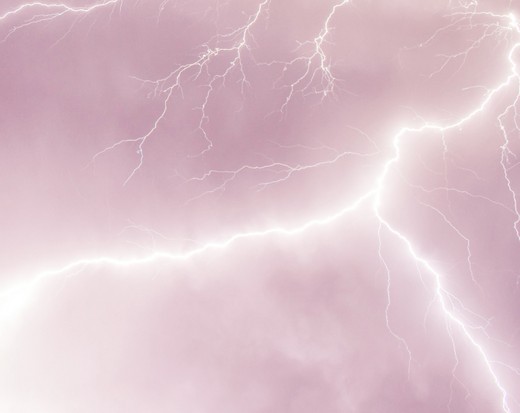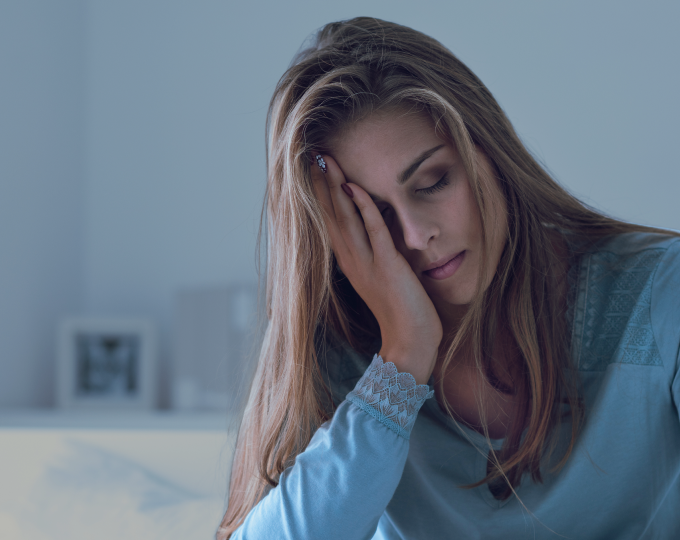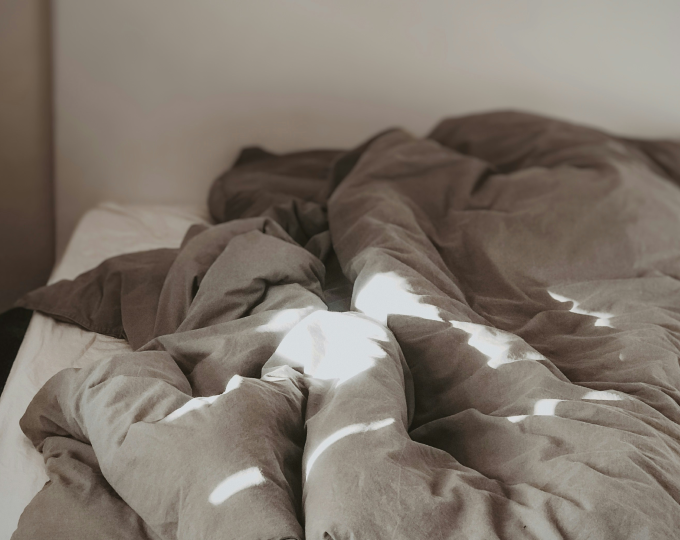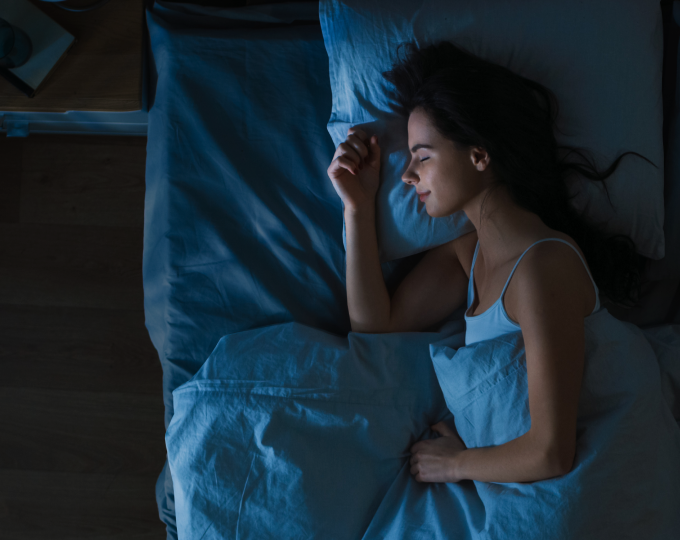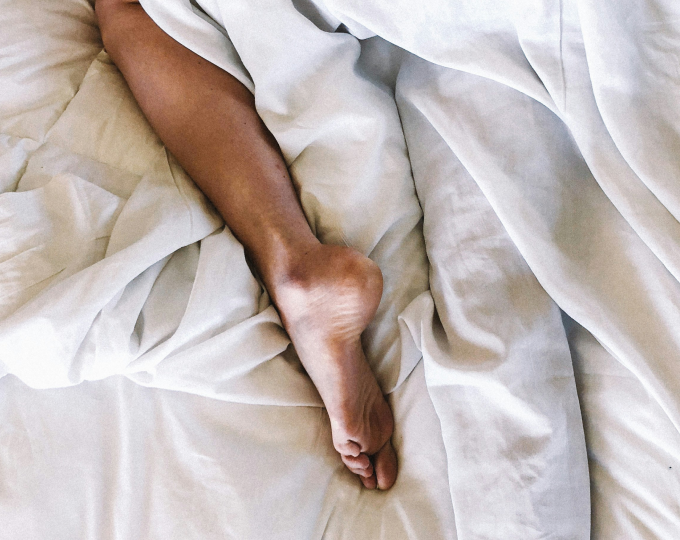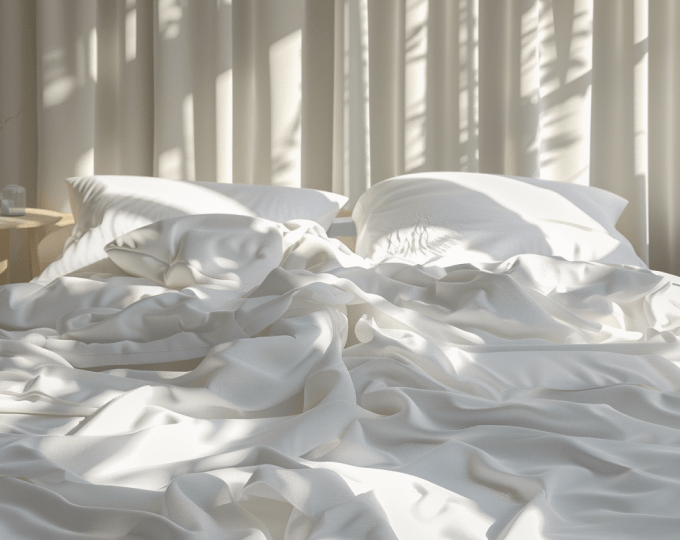Themen dieses Blogartikels:
Table of contents
- What is the sleep cycle?
- What are the phases of our sleep cycle?
- REM and non-REM sleep
- Sleep phase 1: Falling asleep phase (non-REM sleep)
- Why do you sometimes twitch when you fall asleep?
- Sleep phase 2: Light sleep phase (non-REM sleep)
- Sleep stages 3 and 4: Deep sleep stages (non-REM sleep)
- Important for regeneration
- Sleep phase 5: REM sleep
- Eye movements protects you
- The importance of sleep for your wellbeing
- Sleeping cleanses the brain
- Sleeping promotes the regeneration of the musculoskeletal system
- Sleeping helps to process emotions, thoughts and information
- Restful sleep: what is the optimum duration?
- The optimal sleep duration for every age
- Do you often wake up at night?
- What can you do for better sleep and optimal sleep phases?
- Bibliography
What is the sleep cycle?
The sleep cycle is the sequence of different sleep phases. This is because our sleep is not linear, but cyclical. A sleep cycle consists of five sleep phases in which different processes take place in the body. This can be recognized by the fact that the following bodily functions change during the night:
What are the phases of our sleep cycle?
There are a total of five sleep stages (some sources also speak of four stages) that your body goes through several times a night. Exactly how often depends on your individual sleep duration. On average, there are around four to six sleep cycles per night. One of these sleep cycles lasts around 90 minutes.
REM and non-REM sleep
There are also two types of sleep phases: REM sleep and non-REM sleep. REM stands for “rapid eye movement”, as this stage is characterized by rapid eye movements under the closed eyelids.
Good to know: You may have heard that REM sleep is called dream sleep. However, you actually dream not only in this stage, but in all stages of sleep - although dreams are often more vivid in REM sleep, which is why you remember them better.
Within the individual sleep phases, you sleep at different depths and with different levels of restfulness:
- Around 50 minutes are spent falling asleep or light sleep phases.
- Deep sleep and REM sleep make up around 40 minutes of the sleep cycle.
In the first sleep cycle shortly after falling asleep, the deep sleep phase is particularly long and then becomes shorter towards the morning. Conversely, shortly before waking up, the body is increasingly and longer in the REM sleep phase.
To understand why the sleep phases are so important for your well-being, we will now go through a sleep cycle together
Sleep phase 1: Falling asleep phase (non-REM sleep)
Bed is calling. So you snuggle up in your blanket, turn off the light and your cell phone and close your eyes. Ideally, it doesn't take long for the first sleep cycle of the night to start: the phase in which we fall asleep and the minutes that follow.
In this non-REM phase, sleep is still very superficial and light. The body uses this time to relax more and more. Your attention is reduced, muscle activity slows down until you finally drift off to sleep. The hormone melatonin, which prepares the body for sleep, is particularly important for falling asleep.
After around ten to 15 minutes, the body enters the second sleep phase.
Why do you sometimes twitch when you fall asleep?
The brain often falls asleep before the muscles do. Sometimes, however, the muscles continue to report movement impulses - which is why you sometimes have the feeling of falling asleep or feel a muscle twitch in your legs.
Sleep phase 2: Light sleep phase (non-REM sleep)
Light sleep is the transition from wakefulness to sleep and makes up around half of the entire sleep cycle. Your entire body is now set to relax.
Your body temperature drops slightly and your heartbeat and breathing slow down. Sleep is still superficial in this non-REM phase. This means that external stimuli or disturbances can quickly cause you to wake up again.
This phase lasts around 30 minutes and is important as you are now subconsciously starting to process your day and what you have experienced in the office or in your private life.
Sleep stages 3 and 4: Deep sleep stages (non-REM sleep)
The third and fourth sleep phases begin next: the deep sleep phases, which are divided into a phase of medium-deep and very deep sleep and become shorter and shorter from cycle to cycle. In deep sleep, nothing and no one can wake you up so quickly. If you are woken up by something, you will need a moment to regain consciousness.
Important for regeneration
This stage of your sleep cycle determines how well you feel the next day, as it is the most physically and mentally restful. You are now deeply physically relaxed. Your breathing and heart rate are still slowed down, your body temperature remains lowered and your breath comes and goes rhythmically.
The brain and all bodily functions are reduced to a minimum in the deep sleep phase and you are in a phase of regeneration. This is particularly important for athletes. In addition to sleep, vitamins also play a role in your sporting success.
Good to know: If you tend to sleepwalk or talk in your sleep, this is the phase in which these phenomena occur.
Sleep phase 5: REM sleep
The deep sleep phases are followed by a short light sleep phase, which then turns into REM sleep, which is also rather light. In the REM phase, you dream particularly intensely and can remember what your head is doing particularly well. The reason: while your muscles are still resting, your brain is already active again in this phase and processing emotional sensory impressions.
Eye movements protects you
During the rapid eye movement phase, not only does your brain rate increase significantly, but also your heart rate. You breathe quickly and shallowly. The muscles are now completely relaxed and almost completely motionless - with the exception of the eye muscles. During rapid eye movement, your eyes move back and forth quickly. This natural protective mechanism of your body ensures that you do not actually carry out the movements you are dreaming about and thus protects you from injury.
At the end of the REM phase, a new cycle begins in which REM sleep lasts longer than in the first cycle, while the deep sleep phases become shorter and shorter - unless you are woken up by the alarm clock, the morning sun or other external influences and start the new day refreshed.
The importance of sleep for your wellbeing
Sleep, with its phases and cycles, ensures that the body and mind recover and are able to perform at their best the next day. The following three processes enable this regeneration.
Sleeping cleanses the brain
Your central nervous system, which consists of the brain and spinal cord, uses sleep for a thorough cleansing program. This is done by the glymphatic system, which works like a garbage disposal and collects the daily waste products from your nerve cells. This process is particularly important for your cognitive performance.
During the day, there is a lot going on in the nervous system, which is otherwise difficult to access, but at night and especially during deep sleep, the streets are empty and the glymphatic system can work undisturbed.
However, if you suffer from sleep disorders, the body's own waste disposal system cannot work optimally. This increases the risk of neurodegenerative diseases. Among other things, your waste disposal system is responsible for removing so-called amyloid plaques - an accumulation of proteins that are no longer usable.
If these substances remain in your nervous system, they prevent cell metabolism from working properly, which in the worst case can lead to the death of nerve cells.


Advertisement
• Wirkung innerhalb von 5 Minuten
• Für das Einschlafen geeignet
• Aufnahme erfolgt über die Mundschleimhaut
• BIG PACK mit 214 Sprühstößen
• Ohne Alkohol / ohne Kaliumsorbat konserviert
• Mit natürlichem Orangengeschmack
• Zu 100% aus natürlichen Rohstoffquellen gewonnen
• Mit Ärzten & Experten entwickelt

Sleeping promotes the regeneration of the musculoskeletal system
In addition to your brain, your musculoskeletal system uses sleep to regenerate. This is particularly important after strenuous exercise. This is because small tears form within your muscles, which the body can repair best during sleep.
Athletes, watch out: Studies have shown that a lack of sleep is linked to poorer muscle recovery and an increased inflammatory response1. In 2022, a study of young athletes also showed that poor sleep increases susceptibility to musculoskeletal injuries2.
It has long been known that sleep is important for sport and has been the subject of repeated research3. And good sleep is doubly important, especially for athletes: poor sleep increases the risk of injury, while particularly good sleep could even minimize injuries4.
Sleeping helps to process emotions, thoughts and information
An important meeting, a presentation with stage fright or a long-awaited date - every day we gather experiences, experience setbacks and successes and go through a range of emotions. They are all linked to our subconscious. During sleep, it is able to process the experiences in the form of dreams, for example, even if you don't remember most of them the next morning.
Sleep is particularly important for emotional stability, alertness and our daily mood5. Your resilience, i.e. how well you can deal with stress, also depends on your sleep, the phases of sleep and, above all, the quality of your sleep6.
Restful sleep: what is the optimum duration?
Your sleep is restful when the sleep stages follow each other undisturbed and you get enough sleep. But what is enough? The general recommendation for adults is to get seven to eight hours of rest per night.
According to a representative survey from 2022, only 7 percent of adults sleep more than 8 hours, only 41 percent sleep between 7 and 8 hours and over 50 percent get less than 7 hours. Incidentally, when asked about the quality of their sleep, 40 percent of adults in Germany said they slept poorly and a third struggled with sleep problems.7
The optimal sleep duration for every age
However, the ideal sleep duration also depends on your personal needs and your age.
- Newborns up to 3 months old need the most sleep - between 14 and 17 hours.
- Babies aged 4 to 11 months need 12 to 15 hours.
- The ideal sleep duration for toddlers aged 12 months to 2 years is 11 to 14 hours and children aged 3 to 5 years usually need 10 to 13 hours of sleep.
- Schoolchildren between 6 and 13 need 9 to 11 hours, and teenagers from 14 to 17 can get by on 8 to 10 hours of sleep.
- Young adults aged 18 to 25 need 7 to 9 hours, while adults aged 26 to 65 also need 7 to 9 hours, with a minimum of 6 hours.
- From retirement age, the need for sleep can decrease further. Some seniors aged 65 and over only need 5 to 6 hours of sleep, while others like to slumber in bed for up to 9 hours. The general state of health often plays a role here. Some seniors are unable to rest or suffer from sleep disorders.
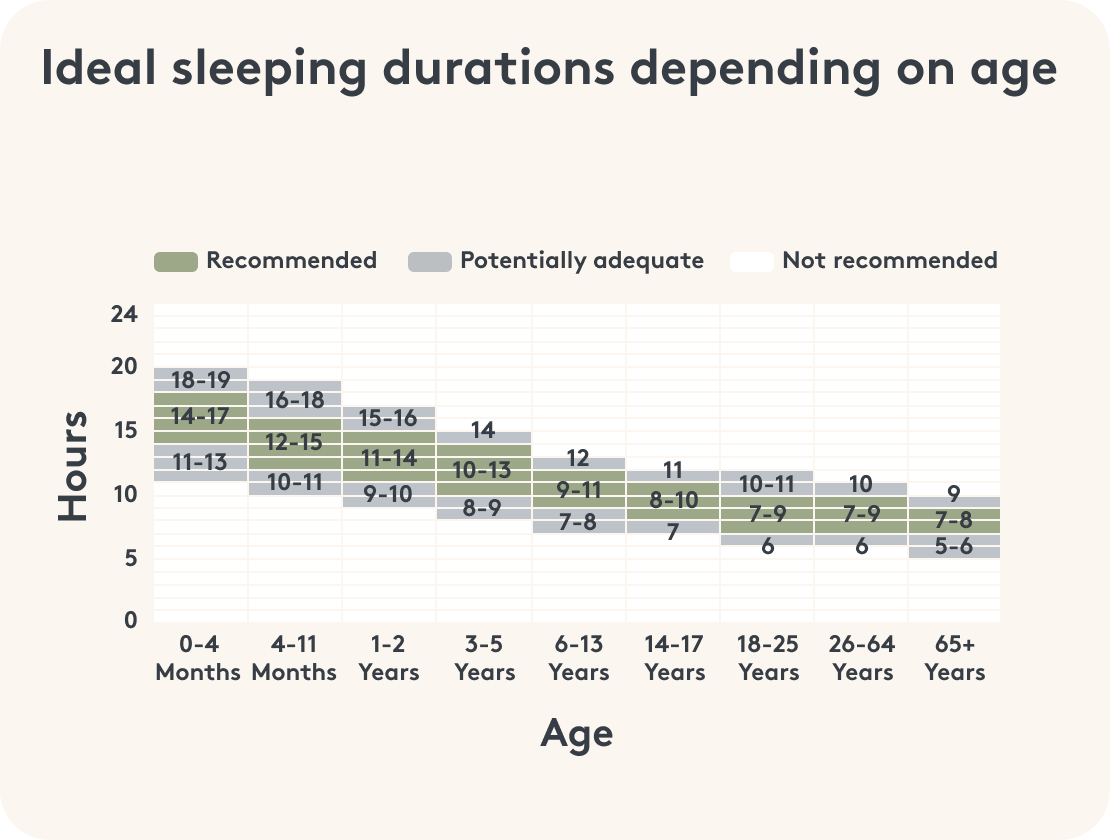

Do you often wake up at night?
It is completely normal to be awake for a few minutes during the sleep phases. On average, adults wake up briefly 10 to 30 times per night. If you are only awake for 2 to 3 minutes, your natural sleep rhythm will not be disturbed and you will not remember waking up in the morning.
It's a different story for people who suffer from sleep disorders: Their sleep rhythm gets mixed up and the five sleep phases no longer follow each other undisturbed. Among other things, constant waking leads to a significant loss of the important recovery in deep sleep.
Sleep is less restful and the glymphatic system cannot work undisturbed. In addition, the sleep phase is often very long, which means that people with sleep disorders wake up more frequently and then lie awake for a long time. This also disrupts the sleep cycle and leads to exhaustion in the morning.
What can you do for better sleep and optimal sleep phases?
Good and restful sleep depends on many factors. Sleep duration is one of them. Once you have found the optimal duration for you, in which you go through four to six sleep cycles and the individual sleep phases one after the other, you will feel good morning after morning.
Routine helps just as much as a conscious diet, sufficient exercise - and our tips for falling asleep and for better sleep hygiene.
This article is based on carefully researched sources:
Bibliography
- Mônico-Neto, M., Dáttilo, M., Ribeiro, D. A., Lee, K. S., de Mello, M. T., Tufik, S., & Antunes, H. K. M. (2017). REM sleep deprivation impairs muscle regeneration in rats. Growth factors (Chur, Switzerland), 35(1), 12–18.
- Viegas, F., Ocarino, J. M., Freitas, L. S., Pinto, M. C., Facundo, L. A., Amaral, A. S., Silva, S., de Mello, M. T., & Silva, A. (2022). The sleep as a predictor of musculoskeletal injuries in adolescent athletes. Sleep science (Sao Paulo, Brazil), 15(3), 305–311.
- Copenhaver, E. A., & Diamond, A. B. (2017). The Value of Sleep on Athletic Performance, Injury, and Recovery in the Young Athlete. Pediatric annals, 46(3), e106–e111.
- Chennaoui, M., Vanneau, T., Trignol, A., Arnal, P., Gomez-Merino, D., Baudot, C., Perez, J., Pochettino, S., Eirale, C., & Chalabi, H. (2021). How does sleep help recovery from exercise-induced muscle injuries?. Journal of science and medicine in sport, 24(10), 982–987.
- Short, M. A., & Chee, M. W. L. (2019). Adolescent sleep restriction effects on cognition and mood. Progress in brain research, 246, 55–71.
- Meerlo, P., Sgoifo, A., & Suchecki, D. (2008). Restricted and disrupted sleep: effects on autonomic function, neuroendocrine stress systems and stress responsivity. Sleep medicine reviews, 12(3), 197–210.
- Ärzteblatt, 09.01.2024. Sleep and relaxation difficult.





